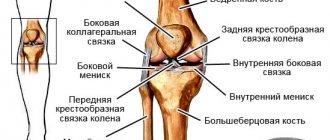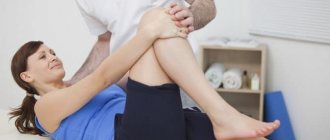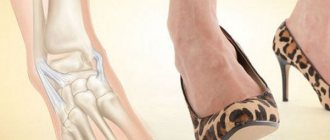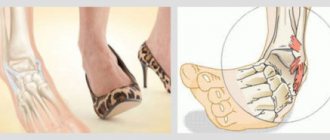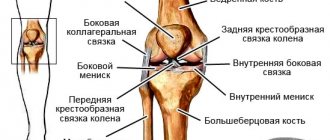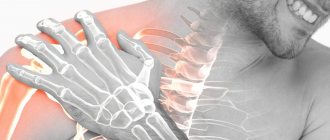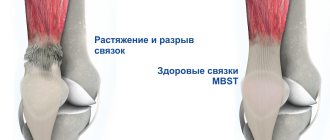An awkward, sudden movement may result in injuries caused by stretching, as well as partial or complete rupture of the tissues connecting bones and joints.
An ankle sprain is not considered a serious problem; in some categories of people, such as professional athletes, it is a common occurrence that can be dealt with on your own after first aid for a sprained ankle.
However, with repeated injuries, the stability of the joint is reduced, which can cause serious consequences. Therefore, it is necessary to properly and promptly treat an ankle sprain.
Causes of sprains
Sprains occur when walking in heels, when slipping, in beginning athletes who have not yet mastered the correct training technique.
The likelihood of sprains is higher if the following factors are present:
- uncomfortable shoes;
- too high or low instep;
- sedentary or hyperactive lifestyle;
- arthritis, arthrosis, history of diabetes mellitus;
- overweight.
What speeds up healing
Ankle surgery to heal a torn ligament.
Rehabilitation according to the therapist’s recommendations is always comprehensive. It includes treatment with medications, massage, physiotherapy, and occasionally surgery. But most patients do not turn to a therapist for treatment, and another part of the patients forgets to follow the instructions. This reduces the rate of healing from a sprain.
The injury will heal faster when using the following elements:
- physiotherapy (hydromassage, electrophoresis);
- gypsum;
- massage (both independent and performed by a master in a medical institution);
- physical therapy (only after primary healing of the ligaments);
- properly administered first aid;
- taking medications (ointment or tablets as prescribed by a doctor).
If one or more elements were prescribed by the therapist, then compliance with them is mandatory. If no appropriate prescription has been received, then you should not “prescribe” procedures and medications for yourself.
Medication treatment can only be done after consultation with a person with medical education.
Degrees of stretch
There are three degrees of injury:
- With a mild sprain, only some fibers are injured, the pain is not severe, and quickly passes after first aid for sprained ankle joints. The joint is functioning normally. Performance is restored within 1–2 weeks.
- When a moderate muscle strain occurs, about half of the muscle fibers are damaged, the pain is sharp, severe, constant, swelling and hematomas are possible. The functionality of the joint is impaired. Treatment until complete recovery takes up to 4–5 weeks.
- In the case of a severe, severe sprain of the ankle, almost all muscle fibers are destroyed, acute pain does not go away for a long time, and the joint is incapacitated. Depending on how an ankle sprain is treated, the recovery period ranges from three months to six months.
Damage classification
For ease of diagnosis and choice of treatment methods, injuries are divided into certain groups. The main criteria are the degree of tissue damage and clinical manifestations. Ligamentous rupture is classified as follows:
- 1st degree . Minor tearing of individual fibers or bundles formed from them. The damaged ankle joint can be easily felt through the skin, the range of motion is slightly impaired or completely preserved. The patient is able to rest on his foot for a short time without feeling significant pain;
- 2nd degree . A tear of a large number of connective tissue fibers is diagnosed. On palpation, the victim complains of pain, and the joint itself can hardly be felt due to increasing swelling. The symptoms are much more pronounced. All attempts by the victim to lean on the injured leg cause severe pain, similar to that arising from dislocations or fractures;
- 3rd degree. With such damage, a complete separation of one, and in some cases several ligaments, occurs from the bone base. The sensations after a ruptured ankle ligament resemble those of a bone fracture. Extensive swelling and hematoma quickly form. The functional activity of the foot is so reduced that emphasis on it is impossible for several reasons. Firstly, it is severe pain. It is so intense that the victim may lose consciousness. Secondly, the anatomical relationship of the articular elements is seriously disturbed.
Regardless of the severity of symptoms, differential diagnosis is indicated for the patient. Its results will help to most informatively assess the degree of damage and the number of complications that have developed.
First aid
Since no one is immune from injury, you need to know what to do if you sprain your ankle.
As first aid for a sprained ankle, you should:
- remove your feet from shoes;
- ask the victim to take a comfortable position;
- elevate your leg to reduce swelling;
- apply a cold compress to the sore area for two to three hours to relieve swelling, taking half-hour breaks to avoid the risk of hypothermia;
- provide fixation of the damaged area by applying a bandage;
- To relieve pain, you can give the victim an over-the-counter pain reliever. Anti-inflammatory drugs and ointments can only be taken as prescribed by a doctor.
Movement amplitude
After an injury, the ankle joint will be stiff and have limited range of motion. It is important to do exercises that will help restore normal range of motion.
Performing circular movements
- One simple exercise involves moving your feet in clockwise and counterclockwise circles.
- To perform this exercise, sit in a comfortable chair or sofa and raise your leg off the floor. Begin to slowly make large circles, clockwise, with your foot at the ankle joint.
- Perform 10 repetitions and then repeat the movement counterclockwise.
Foot Drawing
- Other effective movement exercises include drawing or writing letters, numbers or other symbols with your feet.
- To do this exercise, sit in a chair or sofa with your leg off the floor. Write each letter of the alphabet in the air with your foot, using your big toe as a cursor or pencil.
- If this exercise does not cause pain, repeat the entire alphabet three times.
Movements in the knee joint
Sit in a chair with your feet flat on the floor. Without lifting your feet, carefully bend and straighten your knee joint from side to side. Do this for 3 minutes if the exercise does not cause pain.
Treatment
In case of a mild sprain, it is enough to provide the victim with qualified, quick assistance. For more severe injuries, you need to call a doctor - only he will determine how to treat an ankle sprain effectively and safely.
Therapy consists of taking medications with analgesic and anti-inflammatory effects. After eliminating the swelling, the doctor will recommend taking medications that improve blood microcirculation, applying absorbable ointments and warming medications.
Moderate injury
Moderate sprain
If a moderate sprain occurs, hospitalization and professional examination are no longer necessary. Even though after the examination it is permissible to spend the rest of the treatment period at home, a traumatologist or surgeon should prescribe all the necessary medications and initial therapy.
With this injury, swelling necessarily occurs. It can be extensive, but the hematoma always turns out to be of different sizes. Even the appearance of a small bruise indicates that the sprain is serious.
Painful sensations from injury prevent the patient from standing; he feels a desire to relieve tension and stress from his legs. This is what you need to do: completely protect the damaged area from any impact, and also be sure to visit the emergency room. With an average degree, the therapist prescribes treatment for a period of three weeks to a month or even longer.
In less than three weeks, ligaments do not heal even in people who regenerate at record speed.
Recovery after a sprain
The rehabilitation period for a sprained ankle depends on the severity of the injury, the age and physical condition of the patient. On average, the healing period can last for 1–5 months.
This period can be divided into three stages:
- Reduced symptoms of the acute period. Physiotherapy and massage of the ankle and calf muscles are indicated to speed up healing.
- Preventing muscle atrophy and joint contracture. Exercise therapy in water can help increase the range of motion of a joint.
- Preparing the patient for normal exercise. For this purpose, the exercise therapy complex includes strength exercises and active exercises in the gym.
Stretching for slimming legs
This exercise is effective, but you need to be careful and maintain balance.
- Stand straight on the step platform (you can use improvised things, for example, a thick book).
- Press your toes into the platform, keeping your heel on the floor. Make sure your knee remains straight.
- Shift your weight forward until you feel a stretch in your calf muscles.
- To stretch the soleus muscle, bend your knee slightly.
Muscles involved:
Soleus. Calf.
The video shows how to do this stretch correctly:
Prevention of sprains
Preventive measures are very simple and can be implemented regardless of the level of physical activity:
- choose comfortable shoes for everyday wear and sports;
- regularly engage in moderate physical activity to maintain muscle tone and strengthen the ligamentous apparatus;
- avoid injuries and falls.
Shoe selection
Sprains are common among those who wear high-heeled shoes that do not provide enough support to the foot. To avoid this, it is recommended to wear comfortable shoes with low heels (up to 6–7 cm), and be sure to have a set of sports shoes and accessories for sports.
General recommendations
When actively involved in sports, it is advisable to always have painkillers and an elastic bandage on hand to fix the joint in case of sprain. Self-fixing bandages of varying degrees of extensibility are best suited.
Physiotherapy
Mud baths during the rehabilitation period
Physiotherapeutic exercises are prescribed during the rehabilitation period. They do not require strain on the leg, so they are performed both during the recovery of the ligament and after. The following procedures may be prescribed:
- electrophoresis;
- hydromassage;
- UHF therapy;
- mud baths.
Electrophoresis stimulates the muscles and signals the ligaments to repair. Hydromassage allows the tissues around the ligament to receive additional nutrition, which helps the damaged area itself to recover faster.
Mud baths are a controversial physiotherapy procedure that must take place in a clinic. It is aimed more at reducing swelling than at ligament rehabilitation.
Complications and prognosis
No injury goes away without a trace, especially when it comes to damage to ligaments, because the latter recover very slowly. Even a minor injury is fraught with serious complications, but after more severe injuries they occur even more often. These include:
- sprained ankle;
- flat feet;
- arthritis and arthrosis;
- tendonitis - inflammation of the tendons.
After mild to moderate sprains, the prognosis is generally favorable. In particularly severe cases, there is a high probability of an unfavorable prognosis, such as the development of lameness.
Light exercises
While it is important to perform workouts that specifically target the ankle, it is also important to strengthen and train the rest of the body.
Some types of cardiovascular exercise can be done while recovering from a sprained ankle.
Examples include light exercise such as swimming or riding a stationary bike or elliptical machine. These movements do not put as much stress on the ankle as other exercises such as walking or jogging.
